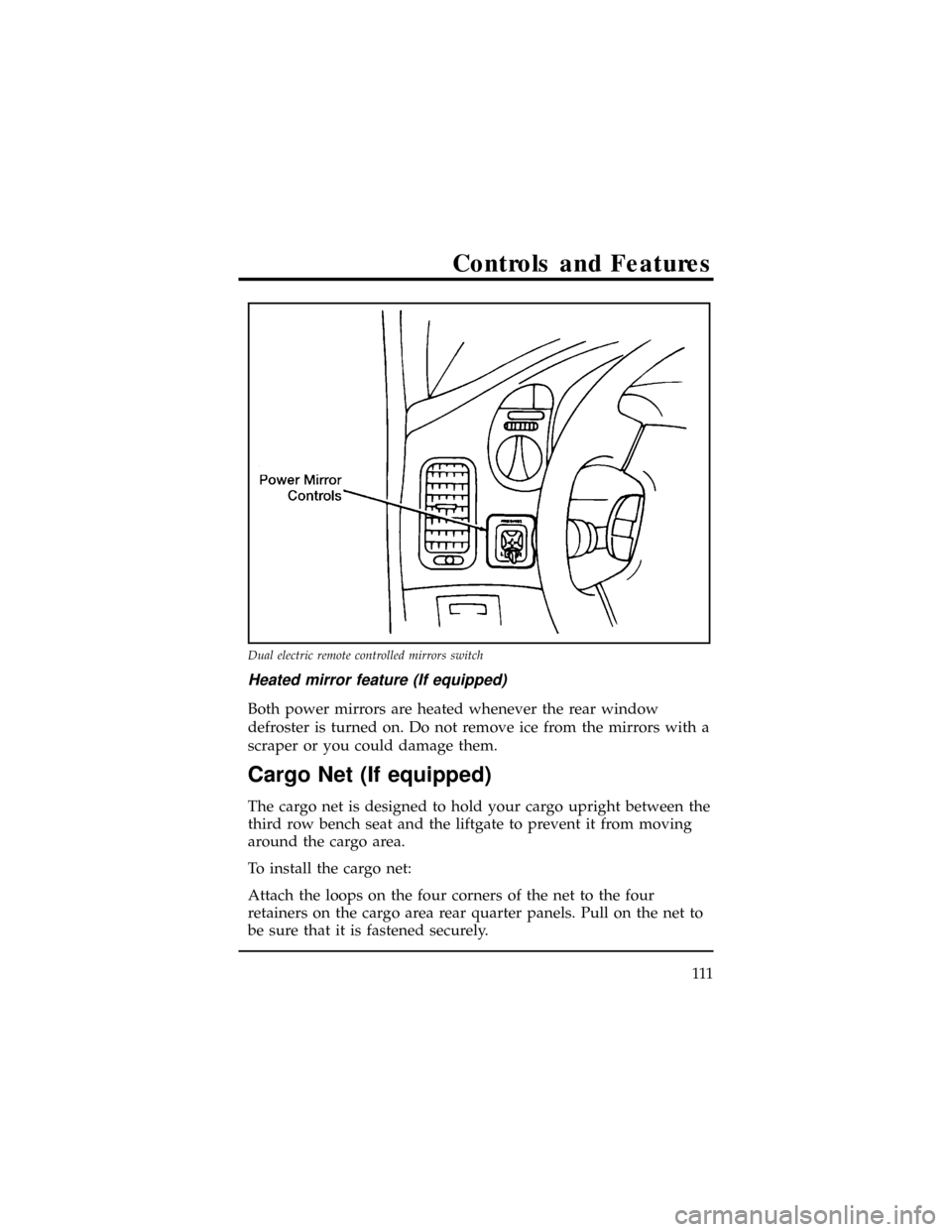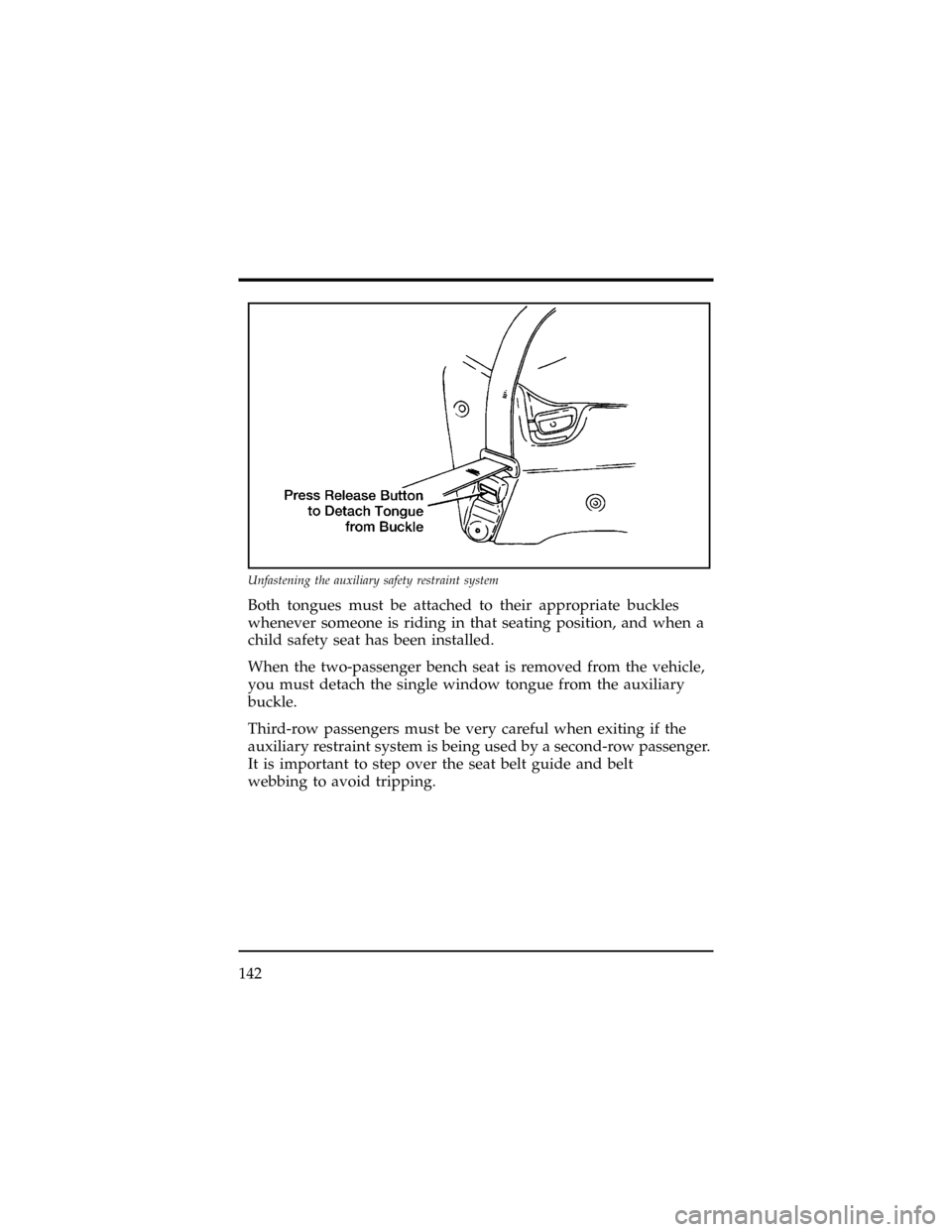window Mercury Villager 1998 s Owner's Guide
[x] Cancel search | Manufacturer: MERCURY, Model Year: 1998, Model line: Villager, Model: Mercury Villager 1998Pages: 400, PDF Size: 2.06 MB
Page 113 of 400

Mirrors
WARNING
Make sure you can see clearly through the rearview mirror
at all times. Do not block your vision. If you cannot see
through the mirror, it could result in a collision, injuring
yourself and others.
Side View Mirrors
Close your door and adjust the driver seat to the most
comfortable position before you adjust the side view mirrors.
If you have manually adjusting side view mirrors, you can adjust
them in any direction by moving the mirror. The mirror heads
can be folded rearward to prevent damage when using an
automatic car wash.
NOTE: Be careful. The convex side view mirror on the right
makes objects appear smaller and farther away than
they actually are. Use the inside rearview mirror (or look
behind you) to determine the actual size and distance
of objects that appear in the convex mirror.
Power quarter window switch
Controls and Features
109
Page 115 of 400

Heated mirror feature (If equipped)
Both power mirrors are heated whenever the rear window
defroster is turned on. Do not remove ice from the mirrors with a
scraper or you could damage them.
Cargo Net (If equipped)
The cargo net is designed to hold your cargo upright between the
third row bench seat and the liftgate to prevent it from moving
around the cargo area.
To install the cargo net:
Attach the loops on the four corners of the net to the four
retainers on the cargo area rear quarter panels. Pull on the net to
be sure that it is fastened securely.
Dual electric remote controlled mirrors switch
Controls and Features
111
Page 132 of 400

Rear Seat Cupholders (available on some models)
Your vehicle may have the following types of cupholders:
mtwo second row cupholders attached to the captain seats (if
equipped)
mtwo third row cupholders on the left side and one cupholder
on the right side (if equipped)
mone cupholder built into the side trim panel (without rear
radio controls)
WARNING
Objects stored on the ledges below the rear side windows
can become dangerous projectiles during a sudden stop
or collision. Put small objects only in the storage
compartments.
Third Row Seat Storage Compartment (If equipped)
Your vehicle may come equipped with a folding cupholder/storage
tray/storage compartment built into the passenger's side of the
third row seat. Find the indented ledge on the right of the
cupholder and pull it up to reveal the storage compartment.
Power Point Electrical Outlet (If equipped)
Your vehicle may be equipped with a 12 volt power point outlet
located just below the rear seat audio controls. The power
point can be used in place of the cigarette lighter for optional
electrical accessories.
NOTE: Do not plug the cigarette lighter into this power point
electrical outlet. Use the cigarette lighter.
128
Page 143 of 400

Auxiliary Safety Restraint System for the Second Row
Bench Seat (7 passenger vehicle)
There is a unique safety restraint system for the outside seating
position of the second row bench seat. It is very important that you
read and understand this section before anyone rides in the
outside seating position (near the sliding door) of the
two-passenger bench seat.
The two-passenger bench seat in the second row has a safety
restraint system made up of two buckles and two tongues. There
is an anchor location at the bottom of the C-pillar and another
anchor location at the top of the C-pillar that attach each end of the
seat belt webbing to the bodyside.
One of the seat belt tongues has two ªwindowsº (or holes) and
the other has only one ªwindow.º The seat belt tongue with one
window attaches to the buckle mounted to the side of the seat.
The seat belt tongue with two windows should be pulled across the
passenger's chest and fastened to the buckle mounted in the
middle of the seat.
Seating and Safety Restraints
139
Page 144 of 400

A twisted belt may prevent the retractor from working
properly. If the unique safety belt system is twisted, disengage
the single window tongue from the buckle on the side of the seat,
remove the twist and re-install the tongue into the buckle until
you hear a snap and feel the latch engage.
The auxiliary safety retraint system for the second row bench seat
140
Page 145 of 400

NOTE: If the three-passenger bench seat is moved up to the
second-row position, the outside passenger (near the
sliding door) only needs to use the double window
tongue and the standard buckle. Because the
third-row seat is wider and is closer to the sliding door,
the single window tongue and the auxiliary buckle
are not necessary.
The auxiliary safety restraint system fastened
Seating and Safety Restraints
141
Page 146 of 400

Both tongues must be attached to their appropriate buckles
whenever someone is riding in that seating position, and when a
child safety seat has been installed.
When the two-passenger bench seat is removed from the vehicle,
you must detach the single window tongue from the auxiliary
buckle.
Third-row passengers must be very careful when exiting if the
auxiliary restraint system is being used by a second-row passenger.
It is important to step over the seat belt guide and belt
webbing to avoid tripping.
Unfastening the auxiliary safety restraint system
142
Page 160 of 400

Using the Automatic Locking Mode Retractor to Secure
a Child Safety Seat
Your vehicle is equipped with a dual locking mode retractor on
the shoulder belt portion of the combination lap/shoulder safety
belt for the front passenger seat and rear outer seats. The
automatic locking modemust be usedwhen installing a child
seat or infant carrier in the front passenger seat or rear outer seats.
To install a child safety seat or infant carrier, follow these steps:
1. Position the child seat or infant carrier in the vehicle seat. If you
are using the moveable third row seat in the third row
position, the passenger side second row bucket seat, or the
front passenger seat, slide the seat to the rearmost position.
2. Follow the child seat or infant carrier manufacturer's
instructions. Route the safety belt through the child seat or
infant carrier and insert the safety belt tongue into the buckle
until you hear and feel the latch engage. Be sure to follow
the child safety seat manufacturer's instructions for belt
routing. When using the seating position near the sliding door
on the two-passenger bench seat, be sure that the single
window tongue is attached to the auxillary buckle on the side
of the seat.
156
Page 216 of 400

5. Check under the vehicle again for leaking fuel. If you see or
smell fuel, do not start your vehicle again. If there is no
fuel, you can try to start your vehicle again.
6. Check all vehicle warning lights before driving your vehicle.
Guarding Against Exhaust Fumes
Carbon monoxide, although colorless and odorless, is present in
exhaust fumes. Take precautions to avoid its dangerous
effects.
WARNING
Do not start your vehicle in a closed garage or in other
enclosed areas. Exhaust fumes can be toxic. Always open the
garage door before you start the engine.
WARNING
If you ever smell exhaust fumes of any kind inside your
vehicle, have your dealer inspect and fix your vehicle
immediately. Do not drive if you smell exhaust fumes.
These fumes are harmful and could kill you.
Have the exhaust and body ventilation systems checked by a
qualified technician whenever:
myour vehicle is raised for service
mthe sound of the exhaust system changes
myour vehicle has been damaged in an accident
Improve your ventilation by keeping all air intake vents clear of
snow, leaves, and other objects.
If the engine is idling while you are stopped in an open area for
long periods of time, open the windows at least one inch (2.5
cm). Also, adjust the heating or air conditioning system to bring
in outside air.
212
Page 316 of 400

mMetric: L/100k = Multiply the number of liters used by 100
and divide the answer by the number of kilometers
travelled.
Comparisons With Environmental Protection Agency
(EPA) Fuel Economy Estimates
EPA fuel economy figures are obtained from laboratory tests
under simulated road conditions and may not reflect the actual
conditions you experience or your style of driving. The EPA fuel
economy estimate is not a guarantee that you will achieve the
fuel economy shown.
The following decrease fuel economy:
mLack of regular, scheduled maintenance
mRapid acceleration and excessive speed
mDriving with your foot on the brake
mSudden stops
mExtended engine idling
mUsing speed control in hilly terrain
mExtended use of the A/C, defroster, rear window defroster
and other accessories
mUnderinflated tires
mHeavy loads
mAftermarket add-ons such as bike, ski or luggage racks, bug
deflectors, etc.
312